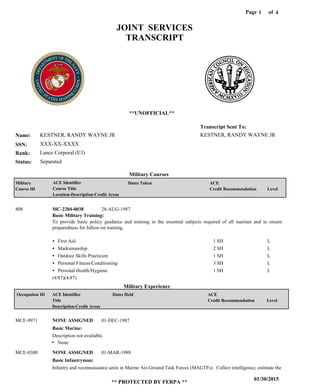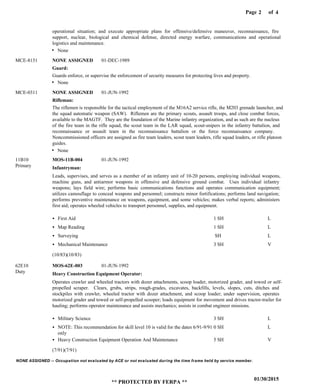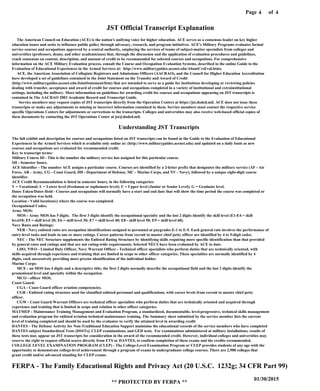Military Transcript
- 1. Page of1 01/30/2015 ** PROTECTED BY FERPA ** 4 KESTNER, RANDY WAYNE JR XXX-XX-XXXX Lance Corporal (E3) KESTNER, RANDY WAYNE JR Transcript Sent To: Name: SSN: Rank: JOINT SERVICES TRANSCRIPT **UNOFFICIAL** Military Courses Military Experience SeparatedStatus: Military Course ID ACE Identifier Course Title Location-Description-Credit Areas Dates Taken ACE Credit Recommendation Level Basic Military Training: 808 28-AUG-1987 To provide basic policy guidance and training in the essential subjects required of all marines and to ensure preparedness for follow-on training. MC-2204-0038 First Aid Marksmanship Outdoor Skills Practicum Personal Fitness/Conditioning Personal Health/Hygiene 1 SH 2 SH 1 SH 3 SH 1 SH L L L L L Basic Marine: Basic Infantryman: NONE ASSIGNED NONE ASSIGNED MCE-9971 MCE-0300 Description not available. Infantry and reconnaissance units in Marine Air-Ground Task Forces (MAGTFs). Collect intelligence; estimate the 01-DEC-1987 01-MAR-1988 None (4/87)(4/87) Level ACE Credit Recommendation Dates HeldACE Identifier Title Description-Credit Areas Occupation ID
- 2. Page of2 01/30/2015 ** PROTECTED BY FERPA ** 4 NONE ASSIGNED -- Occupation not evaluated by ACE or not evaluated during the time frame held by service member. Guard: Rifleman: NONE ASSIGNED NONE ASSIGNED MCE-8151 MCE-0311 operational situation; and execute appropriate plans for offensive/defensive maneuver, reconnaissance, fire support, nuclear, biological and chemical defense, directed energy warfare, communications and operational logistics and maintenance. Guards enforce, or supervise the enforcement of security measures for protecting lives and property. The riflemen is responsible for the tactical employment of the M16A2 service rifle, the M203 grenade launcher, and the squad automatic weapon (SAW). Riflemen are the primary scouts, assault troops, and close combat forces, available to the MAGTF. They are the foundation of the Marine infantry organization, and as such are the nucleus of the fire team in the rifle squad, the scout team in the LAR squad, scout-snipers in the infantry battalion, and reconnaissance or assault team in the reconnaissance battalion or the force reconnaissance company. Noncommissioned officers are assigned as fire team leaders, scout team leaders, rifle squad leaders, or rifle platoon guides. 01-DEC-1989 01-JUN-1992 None None None Infantryman: Heavy Construction Equipment Operator: MOS-11B-004 MOS-62E-003 11B10 62E10 Leads, supervises, and serves as a member of an infantry unit of 10-20 persons, employing individual weapons, machine guns, and antiarmor weapons in offensive and defensive ground combat. Uses individual infantry weapons; lays field wire; performs basic communications functions and operates communication equipment; utilizes camouflage to conceal weapons and personnel; constructs minor fortifications; performs land navigation; performs preventive maintenance on weapons, equipment, and some vehicles; makes verbal reports; administers first aid; operates wheeled vehicles to transport personnel, supplies, and equipment. Operates crawler and wheeled tractors with dozer attachments, scoop loader, motorized grader, and towed or self- propelled scraper. Clears, grubs, strips, rough-grades, excavates, backfills, levels, slopes, cuts, ditches and stockpiles with crawler, wheeled tractor with dozer attachment, and scoop loader; under supervision, operates motorized grader and towed or self-propelled scooper; loads equipment for movement and drives tractor-trailer for hauling; performs operator maintenance and assists mechanics; assists in combat engineer missions. First Aid Map Reading Surveying Mechanical Maintenance Military Science NOTE: This recommendation for skill level 10 is valid for the dates 6/91-9/91 only Heavy Construction Equipment Operation And Maintenance 1 SH 1 SH SH 3 SH 3 SH 0 SH 5 SH L L L V L L V 01-JUN-1992 01-JUN-1992 (10/83)(10/83) (7/91)(7/91) Primary Duty
- 3. Page of3 01/30/2015 ** PROTECTED BY FERPA ** 4 031 Course ID Date Taken Title Location Reason (1) Course has not been evaluated by ACE. (2) Class attendance dates were not recorded in the service member's record. (3) Course was not completed during the ACE evaluation period. (4) Course was not evaluated by ACE at this specific location. Other Learning Experiences College Level Test Scores Infantry Rifleman No Location Given 4,2 MC-2204-0051 1988 NONE This section provides a record of the service member's learning experiences that do not have credit recommended for one or more of the following reasons: END OF TRANSCRIPT *NOTICE TO ALL TRANSCRIPT REVIEWERS: FOR FULL EXPLANATIONS OF ALL ITEMS FLAGGED ON THIS TRANSCRIPT, PLEASE REFER TO LEGEND FOLLOWING LAST PAGE OF TRANSCRIPT. Exams taken after 31 October 2011 may have recommended college credit via the ACE National Guide. Go to http://www2.acenet.edu/credit/?fuseaction=browse.getOrganizationDetail&FICE=190163 and look for your exam.
- 4. Page of4 01/30/2015 ** PROTECTED BY FERPA ** 4 JST Official Transcript Explanation The American Council on Education (ACE) is the nation's unifying voice for higher education. ACE serves as a consensus leader on key higher education issues and seeks to influence public policy through advocacy, research, and program initiatives. ACE's Military Programs evaluates formal service courses and occupations approved by a central authority, employing the services of teams of subject-matter specialists from colleges and universities (professors, deans, and other academicians) that, through the discussion and the application of evaluation procedures and guidelines, reach consensus on content, description, and amount of credit to be recommended for selected courses and occupations. For comprehensive information on the ACE Military Evaluation process, consult the Course and Occupation Evaluation Systems, described in the online Guide to the Evaluation of Educational Experiences in the Armed Services at: http://www.militaryguides.acenet.edu/AboutCrsEval.htm). ACE, the American Association of Collegiate Registrars and Admissions Officers (AACRAO), and the Council for Higher Education Accreditation have developed a set of guidelines contained in the Joint Statement on the Transfer and Award of Credit (http://www.militaryguides.acenet.edu/JointStatement/htm) that are intended to serve as a guide for institutions developing or reviewing policies dealing with transfer, acceptance and award of credit for courses and occupations completed in a variety of institutional and extrainstitutional settings, including the military. More information on guidelines for awarding credit for courses and occupations appearing on JST transcripts is contained in The AACRAO 2003 Academic Record and Transcript Guide. Service members may request copies of JST transcripts directly from the Operation Centers at https://jst.doded.mil. ACE does not issue these transcripts or make any adjustments to missing or incorrect information contained in them. Service members must contact the respective service specific Operations Centers for adjustments or corrections to the transcripts. Colleges and universities may also receive web-based official copies of these documents by contacting the JST Operations Center at jst@doded.mil. Understanding JST Transcripts The full exhibit and description for courses and occupations listed on JST transcripts can be found in the Guide to the Evaluation of Educational Experiences in the Armed Services which is available only online at: (http://www.militaryguides.acenet.edu) and updated on a daily basis as new courses and occupations are evaluated for recommended credit. Key to transcript terms: Military Course ID - This is the number the military service has assigned for this particular course. SH - Semester hours. ACE Identifier - The number ACE assigns a particular course. Courses are identified by a 2-letter prefix that designates the military service (AF - Air Force, AR - Army, CG - Coast Guard, DD - Department of Defense, MC - Marine Corps, and NV - Navy), followed by a unique eight-digit course identifier. ACE Credit Recommendation is listed in semester hours, in the following categories: V = Vocational; L = Lower level (freshman or sophomore level); U = Upper level (Junior or Senior Level); G = Graduate level. Dates Taken/Dates Held - Courses and occupations will normally have a start and end date that will show the time period the course was completed or the occupation was held. Location - Valid location(s) where the course was completed. Occupational Codes: Army MOS: MOS - Army MOS has 5 digits. The first 3 digits identify the occupational specialty and the last 2 digits identify the skill level (E1-E4 = skill level10; E5 = skill level 20; E6 = skill level 30; E7 = skill level 40; E8 - skill level 50; E9 = skill level 60). Navy Rates and Ratings: NER - Navy enlisted rates are occupation identifications assigned to personnel at paygrades E-1 to E-9. Each general rate involves the performance of entry-level tasks and leads to one or more ratings. Career patterns from recruit to master chief petty officer are identified by 4 to 5-digit codes. NEC - The NEC Structure supplements the Enlisted Rating Structure by identifying skills requiring more specific identification than that provided by general rates and ratings and that are not rating-wide requirements. Selected NECS have been evaluated by ACE to date. LDO, NWO - Limited Duty Officer, Navy Warrant Officer - Technical officer specialists who perform duties that are technically oriented, with skills acquired through experience and training that are limited in scope to other officer categories. These specialties are normally identified by 4 digits, each successively providing more precise identification of the individual holder. Marine Corps: MCE - an MOS has 4 digits and a descriptive title; the first 2 digits normally describe the occupational field and the last 2 digits identify the promotional level and specialty within the occupation. MCO - officer MOS. Coast Guard: CGA - Coast Guard officer aviation competencies. CGR - Enlisted rating structure used for classified enlisted personnel and qualifications, with career levels from recruit to master chief petty officer. CGW - Coast Guard Warrant Officers are technical officer specialists who perform duties that are technically oriented and acquired through experience and training that is limited in scope and relation to other officer categories. MATMEP - Maintenance Training Management and Evaluation Program, a standardized, documentable, level-progressive, technical skills management and evaluation program for enlisted aviation technical maintenance training. The Summary sheet submitted by the service member lists the current level of training completed and should be used by the evaluator to verify the attained level in awarding credit. DANTES - The Defense Activity for Non-Traditional Education Support maintains the educational records of the service members who have completed DANTES subject Standardized Tests (DSSTs), CLEP examinations, and GED tests. For examinations administered at military installations, results of these tests may appear on JST transcripts for consideration in the award of the recommended credit. However, individual colleges and universities may reserve the right to request official scores directly from ETS or DANTES, to confirm completion of these exams and the credits recommended. COLLEGE LEVEL EXAMINATION PROGRAM (CLEP) - The College-Level Examination Program or CLEP provides students of any age with the opportunity to demonstrate college-level achievement through a program of exams in undergraduate college courses. There are 2,900 colleges that grant credit and/or advanced standing for CLEP exams. FERPA - The Family Educational Rights and Privacy Act (20 U.S.C. 1232g; 34 CFR Part 99)




